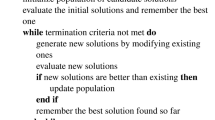Abstract
This paper presents a new optimization algorithm based on some principles from physics and mechanics, which will be called Charged System Search (CSS). We utilize the governing Coulomb law from electrostatics and the Newtonian laws of mechanics. CSS is a multi-agent approach in which each agent is a Charged Particle (CP). CPs can affect each other based on their fitness values and their separation distances. The quantity of the resultant force is determined by using the electrostatics laws and the quality of the movement is determined using Newtonian mechanics laws. CSS can be utilized in all optimization fields; especially it is suitable for non-smooth or non-convex domains. CSS needs neither the gradient information nor the continuity of the search space. The efficiency of the new approach is demonstrated using standard benchmark functions and some well-studied engineering design problems. A comparison of the results with those of other evolutionary algorithms shows that the proposed algorithm outperforms its rivals.
Similar content being viewed by others
References
Kaveh, A., Talatahari, S.: An improved ant colony optimization for constrained engineering design problems. Engineering Computations 27(1) (2010, in press)
Fogel L.J., Owens A.J., Walsh M.J.: Artificial Intelligence Through Simulated Evolution. Wiley, Chichester (1966)
De Jong, K.: Analysis of the behavior of a class of genetic adaptive systems. Ph.D. Thesis, University of Michigan, Ann Arbor, MI (1975)
Koza, J.R.: Genetic programming: a paradigm for genetically breeding populations of computer programs to solve problems. Report No. STAN-CS-90-1314, Stanford University, Stanford, CA (1990)
Holland J.H.: Adaptation in Natural and Artificial Systems. University of Michigan Press, Ann Arbor (1975)
Goldberg D.E.: Genetic Algorithms in Search Optimization and Machine Learning. Addison-Wesley, Boston (1989)
Glover F.: Heuristic for integer programming using surrogate constraints. Decis. Sci. 8(1), 156–166 (1977)
Dorigo M., Maniezzo V., Colorni A.: The ant system: optimization by a colony of cooperating agents. IEEE Trans. Syst. Man Cybern. B 26(1), 29–41 (1996)
Eberhart, R.C., Kennedy, J.: A new optimizer using particle swarm theory. In: Proceedings of the sixth international symposium on micro machine and human science, Nagoya, Japan (1995)
Kirkpatrick S., Gelatt C., Vecchi M.: Optimization by simulated annealing. Science 220(4598), 671–680 (1983)
Erol O.K., Eksin I.: New optimization method: Big Bang–Big Crunch. Adv. Eng. Softw. 37, 106–111 (2006)
Kaveh A., Talatahari S.: Size optimization of space trusses using Big Bang–Big Crunch algorithm. Comput. Struct. 87(17–18), 1129–1140 (2009)
Rashedi E., Nezamabadi-pour H., Saryazdi S.: GSA: a gravitational search algorithm. Inf. Sci. 179, 2232–2248 (2009)
Halliday D., Resnick R., Walker J.: Fundamentals of Physics, 8th edn. Wiley, New York (2008)
Kaveh A., Talatahari S.: Particle swarm optimizer, ant colony strategy and harmony search scheme hybridized for optimization of truss structures. Comput. Struct. 87(5–6), 267–283 (2009)
Coello C.A.C.: Theoretical and numerical constraint-handling techniques used with evolutionary algorithms: a survey of the state of the art. Comput. Methods Appl. Mech. Eng. 191(11–12), 1245–1287 (2002)
Kaveh A., Talatahari S.: A particle swarm ant colony optimization for truss structures with discrete variables. J. Constr. Steel Res. 65(8–9), 1558–1568 (2009)
Tsoulos I.G.: Modifications of real code genetic algorithm for global optimization. Appl. Math. Comput. 203, 598–607 (2008)
Belegundu, A.D.: A study of mathematical programming methods for structural optimization. Ph.D. thesis, Department of Civil and Environmental Engineering, University of Iowa, Iowa, USA (1982)
Arora J.S.: Introduction to Optimum Design. McGraw-Hill, New York (1989)
Coello C.A.C.: Use of a self-adaptive penalty approach for engineering optimization problems. Comput. Ind. 41, 113–127 (2000)
Coello C.A.C., Montes E.M.: Constraint-handling in genetic algorithms through the use of dominance-based tournament selection. Adv. Eng. Inform. 16, 193–203 (2002)
He Q., Wang L.: An effective co-evolutionary particle swarm optimization for constrained engineering design problems. Eng. Appl. Artif. Intell. 20, 89–99 (2007)
Montes E.M., Coello C.A.C.: An empirical study about the usefulness of evolution strategies to solve constrained optimization problems. Int. J. Gen. Syst. 37(4), 443–473 (2008)
Ragsdell K.M., Phillips D.T.: Optimal design of a class of welded structures using geometric programming. ASME J. Eng. Ind. Ser. B 98(3), 1021–1025 (1976)
Deb K.: Optimal design of a welded beam via genetic algorithms. Am. Inst. Aeronaut. Astronaut. J. 29(11), 2013–2015 (1991)
Sandgren, E.: Nonlinear integer and discrete programming in mechanical design. In: Proceedings of the ASME design technology conference, Kissimine, FL, pp. 95–105 (1988)
Kannan B.K., Kramer S.N.: An augmented Lagrange multiplier based method for mixed integer discrete continuous optimization and its applications to mechanical design. Trans. ASME J. Mech. Des. 116, 318–320 (1994)
Deb K., Gene A.S.: A robust optimal design technique for mechanical component design. In: Dasgupta, D., Michalewicz, Z. (eds) Evolutionary Algorithms in Engineering Applications, pp. 497–514. Springer, Berlin (1997)
Author information
Authors and Affiliations
Corresponding author
Rights and permissions
About this article
Cite this article
Kaveh, A., Talatahari, S. A novel heuristic optimization method: charged system search. Acta Mech 213, 267–289 (2010). https://doi.org/10.1007/s00707-009-0270-4
Received:
Revised:
Published:
Issue Date:
DOI: https://doi.org/10.1007/s00707-009-0270-4




